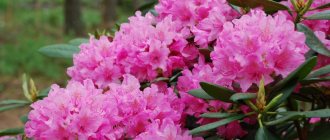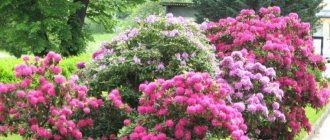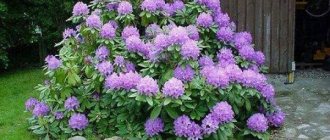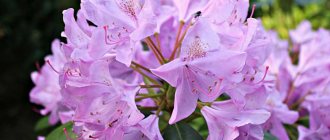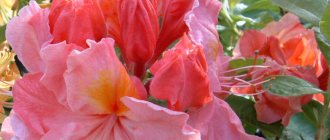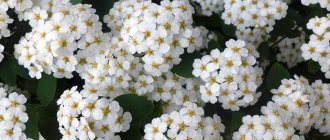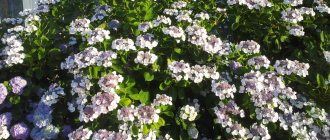Homeland of the plant
Rhododendron Katevbinsky appeared in Europe in 1809, it was brought from North America. It was one of the first introduced species, which spread very quickly due to its unpretentiousness and winter hardiness.
Full size shrub
For your information! At the moment, the species is actively used not only in landscape design, but also in breeding programs to obtain new evergreen frost-resistant varieties.
In nature, rhododendron can be found in North America, in particular in its eastern part, in the Allegheny Mountains. Shrubs form entire fields in open areas or grow in groups among forests. Emerald green specimens are also common in Japan.
The flower came to Latvia in the mid-19th century; in the climatic conditions of the Baltic states, rhododendron blooms and bears fruit profusely. Thanks to the shrub’s ability to withstand frosts down to −30°C, it can be found in the Far East and Kamchatka.
Rhododendron - care, soil selection, reproduction, wintering
Rhododendron is a wonderful plant of the heather family, which, however, is not easy to grow in our northern latitudes. Their homeland is the Mediterranean, so they are very thermophilic and do not tolerate Russian winters well. “Sissies”, in a word.
In order for them to take root, they need proper care and adherence to proper agricultural practices. But this flower is so charming that an increasing number of experienced and novice gardeners are trying their hand at cultivating it.
It should be noted that there are many pitfalls and nuances in caring for rhododendron. Let's list some of them.
Selection of planting material
There are several winter-hardy species of this evergreen plant that have a chance to survive even with not very skillful care. These include the following species: Katevbinsky, deciduous Schlippenbach and Japanese.
Katevba rhododendron grows wild in North America in the highlands of North Carolina, where the Katevba River, which gave it its specific name, originates. Grows well in the shade on acidic or slightly acidic soils. It tolerates our winters very well. The height of the bush is 2-4 meters, the leaves are leathery, dark green, 15 cm long.
The flowers are large, very beautiful, lilac-purple in color, up to 15 cm in diameter. Recommended for group and single plantings in gardens and forest edges in the northwestern zone of Russia.
Schlippenbach rhododendron grows in the forests of Korea, Japan, Northeast China and Western Primorye. The name is due to the Russian naval officer and traveler - A.V. Schlippenbach. Frost-resistant, shoots appear annually.
Can reproduce by rooting branches and seeds. The height of the cultivated plant reaches 1.6 m. The leaves are wide, falling, and in the fall they turn bright yellow-red.
The flowers are large (up to 10 cm in diameter), the color is pale pink, diluted with purple specks.
Japanese rhododendron grows on the sun-drenched mountainous slopes of the island of Honshu. Winter-hardy, light-loving. Propagates well by cuttings and seeds. Very handsome. During the flowering period, from a distance it looks like the flame of a bright fire.
Moreover, it remains this way until late autumn, due to the coloring of the leaves in orange-red tones. Flowers with a tart aroma, large, orange in color. In beauty during the flowering period it surpasses all other species that can grow in central Russia.
The bush grows very dense due to strong branching and reaches a height of up to 2 meters.
Botanical description of Rhododendron Grandiflorum
Catawbiense rhododendron (lat. Rhododéndron Catawbiense) is a type of evergreen shrub whose lifespan reaches 100 years.
Caucasian rhododendron in the mountains: when to bloom
In suitable growing conditions it can reach a height of 2 to 4 m, and the plant is wider than it is tall. By the age of 10, it reaches 1.5 m in height, adding 10 cm per year.
While the plant is young, its shoots have a felt surface; over time they become smooth. The leaves are oblong, the ends can be both blunt and sharp, the maximum length is 15 cm, width 5 cm. The upper part of the leaf is dark green, has 16 pairs of veins, the lower part is pale, bare.
The most popular varieties:
- Catawbiense Grandiflorum (Rhododendron Catawbiense Grandiflorum);
- Album Novum (Rhododendron Catawbiense Album Novum);
- Roseum elegans (Rhododendron Catawbiense Roseum Eleganсe);
- Purpureum (Rhododendron purpureum grandiflorum).
For your information! The flowering period lasts from late May to mid-June, sometimes lasting until July. The fruits ripen in October.
The description of the rhododendron Catawbiense Grandiflorum states that this is the oldest and most popular hybrid variety, which was obtained from a wild plant in the early 19th century. The crown reaches 3.5 m in diameter, the flowers are lilac with yellow and orange specks.
Description
Rhododendron is a shrub reaching a height of 4-4.5 m. Its leaves have an elongated shape, rich green color with a glossy sheen. The lifespan and growth of rhododendron is approximately 100 years. The plant appears uniquely beautiful during flowering, when the entire bush is literally strewn with flowers with a radius of up to 3 cm. Their shape resembles a bell, they are collected in clusters of about 20 pieces. Flower colors are varied:
- white;
- cream;
- violet;
- red with a purple tint;
- lilac;
- lilac.
Katevbinsky rhododendron is planted in alleys near benches, at the turns of garden paths. This light-loving plant, however, can tolerate light scattered by tree foliage. The only thing the shrub is afraid of is drafts, so choose the place to plant it carefully. Rhododendron Katevbinsky was taken by breeders to develop the following varieties:
- "Grandiflorum";
- "Purpureum";
- "Roseum elegans";
- "Album";
- "Burso";
- "Homebush."
Grandiflorum ("Grandiflorum")
This is the most common variety of rhododendron, which was one of the first to be bred. It is distinguished by its resistance to frost down to -32 C and rapid growth. The crown span is approximately 3.5 m and the height is 3 m. The flowers have a purple hue with orange speckles and are odorless. Inflorescences appear in early summer.
Purpureum ("Purpureum")
One of the young varieties of rhododendron, bred on the basis of “Grandiflorum”. Therefore, it is also distinguished by frost resistance down to -30 C, strong and tough shoots. In the Urals the height is 1.5 m, and in warm areas up to 2.5-3.0 m. It does not shed its leaves in winter. Blooms in June with lilac-violet flowers.
Roseum Elegans
It is distinguished by its slow growth, delicate pink-purple inflorescences, resistance to frost, intolerance to winds and bright spring sun. The shrub is spreading, its shoots are strongly branched.
Album
So called for its snow-white flowers with an olive speck. It reaches a height of 2 m. It is resistant to frost, blooms in late spring - early summer. Can be used both for single planting and for creating compositions.
Boursault
The variety was bred in 1849 for cultivation in the northeastern United States. It is a fast-growing shrub, 2 m wide and up to 2 m high. It blooms in early summer with dark purple buds.
Homebush
This is the second name for deciduous rhododendron, which distinguishes it from previous evergreen varieties. It grows at an average rate and by the age of 10 reaches 1.5-2.0 m. It has original double, pointed pink flowers, collected in spherical inflorescences. Withstands temperatures down to -30 C, does not require shelter.
Flowering of Katevbinsky rhododendron
Flower growers have fallen in love with the large-flowered rhododendron Catawbiense Grandiflorum for a reason. It is highly decorative all year round. While the bush has not bloomed its flowers, it attracts the eye due to its bright, large, smooth leaves.
Rhododendron yellow: deciduous, azalea pontica
Flowering lasts only a month. Each inflorescence consists of 15-20 flowers. The inflorescences are bell-shaped and wide-funnel-shaped, reaching a diameter of 15 cm. Each flower is a bell and can be white, yellow, violet, red, purple or lilac.
In order for flowering to be spectacular and bright, the shrub needs to be watered and fed abundantly before and after this period. This way the plant will be saturated with nutrients and will not be depleted.
Note! If the rhododendron does not bloom, most likely the growing location is not suitable for it and there is not enough moisture.
Rhododendron leaves close up
Features of reproduction
Rhododendron Schlippenbach: description
At home, rhododendron propagates by layering and cuttings.
Cuttings are cut in early summer. Each branch up to 15 cm long is cut at an angle of 45°, the lower leaves are removed, and the cuttings themselves are placed in a root formation stimulator for a day. After this, each shoot is planted in a fertile acidic substrate for rhododendrons and a greenhouse is made. Rooting will occur in about a month.
Scheme of propagation by cuttings
An easier way is propagation by layering. To do this, the lower branches are tilted to the ground and sprinkled. The edge of the shoot is tied to a peg. After a few months, the cuttings will produce roots and can be separated from the mother plant in the spring.
Important! For the rooting process to be successful, the soil with layerings must be well moistened.
Reproduction methods
Like many other garden plants, adult rhododendron grandiflorum can be propagated in several basic ways: by seed, using cuttings or layering. Each of them has its own characteristic features, which the gardener should know about immediately before starting work.
Seeds
The seed method of propagating this crop is deservedly considered one of the most labor-intensive, so most gardeners resort to it only in extreme cases.
However, this does not mean that the description of the planting process is devoid of relevance, so every gardener should know what stages it consists of:
- To begin, prepare a suitable planting container with drainage holes at the bottom and fill it with peat or heather soil mixed with sand in a 3:1 ratio.
- Level the surface of the substrate and spread the seeds without pressing them deep into the soil (there should be a distance of at least 2 cm between adjacent seeds).
- Sprinkle the seeds with a small amount of sand and cover the seedling box with glass or plastic film to create a greenhouse effect inside.
Further care of the seedlings consists of periodic ventilation and moistening of the plantings with a spray bottle. In suitable conditions, the first shoots of rhododendron Grandiflorum will appear after a month. After two true leaves have formed on the young stems, it is worth planting the plants in different containers to form a good root system for each specimen.
For the entire next year after planting, the seedlings are grown in greenhouse but cool conditions, and only the strengthened seedlings are moved to prepared beds in the open ground. With this method of cultivation, you should not wait until 6–8 years for the first flowers to appear on the bushes.
By cuttings
Suitable planting material for propagating rhododendron by cuttings will be semi-lignified segments of shoots, 5–8 cm long. The lower leaves of these parts are removed, and the cutting itself is lowered into a root formation stimulator (cut down). The future shrub must remain in “Kornevin” or “Epin” for at least 16 hours, after which it is transferred to a mixture of peat and sand, combined in a 3:1 ratio.
As when planting seeds, the cuttings are covered with polyethylene or an inverted jar during rooting to create greenhouse conditions. The soil under the shelter should not dry out, so soil moisture and periodic ventilation are mandatory aspects of productive growing of cuttings.
The average rooting period is 2–4 months, but in the cold season it is advisable to place the plants in a cool room, with temperatures of +8…+12°C. In the spring, the cuttings can be transplanted into open ground along with a seedling container, and after complete rooting, they can be moved to a permanent growing place, having already been removed from the box.
Did you know? Certain varieties of the described plant (for example, R. ponticum and R. luteum) should not be grown near the apiary. The pollen of the flowers of such bushes contains toxic substances, which, if they get into honey and are subsequently consumed by humans, can cause not only a runny nose and cough, but also hallucinations.
By layering
Obtaining new rhododendron Grandiflorum plants using layering is deservedly considered the least labor-intensive way to propagate a plant, and all that is required from the gardener is:
- Dig a ditch up to 5 cm deep next to the bush.
- Select a healthy lower shoot of the mother bush.
- Place it in an organized trench and pin it to the ground with metal staples.
- Cover the main part of the branch with a mixture of soil and peat, and bring the remaining end above the soil surface and tie it to a wooden stake driven next to the bush.
Throughout the summer season, the cuttings are watered in the same way as the mother bush, and the next year, as soon as the buried part is completely rooted, it can be disconnected from the main plant and planted in a prepared area, like a regular seedling. Further care should be carried out in accordance with the general rules for caring for rhododendron.
Landing rules
Despite the unpretentiousness of rhododendron Grandiflorum and the ease of caring for it, some conditions must be met. An incorrectly selected soil composition can lead to a lack of flowering or the death of the entire shrub. If you choose the right planting site, then nothing else is required except watering.
Boarding time
The plant should be planted in a permanent place before flowering - in early spring after frost or in early autumn. Rhododendrons have a shallow root system, so the top layer of soil should already be warmed up, and precipitation could not harm the shrub.
Flower shoots are sensitive to drought, so the mid-season is best for replanting.
Place and soil for planting rhododendron katevbinskogo Grandiflorum
Rhododendron Grandiflora tolerates shade well, but will still feel better on the south side, but without direct sunlight. Places with diffused light, such as under trees or a canopy, are also suitable.
Important! When choosing a place to plant, you need to check in advance whether there are any drafts there. Constant winds can dry out the shoots of the plant.
Soil requirements:
- slightly acidic or sour;
- wet;
- loose;
- rich in organic matter.
Before planting, the rhododendron can be placed in water so that it is saturated with moisture. Increased soil and air humidity is the key to good flowering. Therefore, it is recommended to install automatic waterers in the garden plot or manually spray the shoots daily.
Note! It is better to plant shrubs next to those trees that have similar soil requirements. This way, neighbors will not take nutrients from each other. Fruit trees can lead to depletion of shrubs, as they draw all the water from the soil.
If there is frequent precipitation in the region, this can lead to stagnation of moisture, which leads to rotting of the roots. To protect the ornamental shrub, it is better to immediately plant it on a hill. In temperate climates, a drainage layer is made in the planting hole.
To acidify the soil, you can mix several types of soil: garden soil, peat soil, rotted pine soil, clay soil, and add sand. Sand and clay should be no more than 20% to maintain breathability.
How Rhododendron Grandiflorum blooms
Seedling preparation
It is best to use a seedling that is three years old, but the possibility of transplanting younger or older specimens is not excluded.
Before planting, the shrub is dipped in a container of water until no more air bubbles are released. Long roots can be trimmed, the rest can be simply straightened.
Important! When planting, the root collar of the Katevbinsky Grandiflorum rhododendron should remain above the ground.
Fertilizer application
Rhododendron katevbinsky Grandiflora absorbs many nutrients. In poor soils, its leaves will become pale and thin, and very few flowers will appear during the flowering period.
To avoid the above, plants are fed from the beginning of spring until the end of flowering. This is necessary for both young and adult shrubs. The last feeding is carried out when the bush has completely faded and new shoots begin to form.
Suitable for Rhododendron catawbiens Grandiflorum:
- organic fertilizers, in particular, semi-rotted cow manure, diluted in water in a ratio of 1:15;
- horn flour;
- calcium and magnesium sulfate;
- potassium nitrate.
At the beginning of spring, nitrogen preparations are introduced into the soil, in June compositions with potassium and phosphorus, and in July nitrogen is excluded.
Note! To preserve moisture and nutrients in the soil, the tree trunk circle of the shrub is mulched with pine needles.
Instructions for planting rhododendron Katevbinsky "Grandiflorum"
- Water the seedling generously, and if the root ball is dry, then soak it in a bucket of water for 40-50 minutes so that all air bubbles come out and it is saturated with moisture.
- Dig a planting hole approximately twice the size of the seedling's root ball (depth - 34-40, width - 45-60 cm).
- Make a drainage layer at the bottom of the hole from broken red brick, sand, fine gravel, pebbles or crushed granite - 7-8 cm.
- Pour a little soil mixture (8-10 cm layer) and pour 4-5 liters of water into the hole so that the bottom layer is well saturated.
- Then place the seedling so that the root collar is 3-5 cm higher than the ground level. And after compacting the soil mixture and watering, the base of the bush will be exactly at ground level. Gradually fill in the substrate and compact it.
- Water the tree trunk circle with 6-8 liters of water. If the soil settles too much, add the mixture.
- Apply a 6-8 cm layer of mulch from peat, heather soil, pine needles or leaves of oak, birch or linden to retain moisture, increase acidity and the amount of humus. The root collar cannot be covered; it is better to sprinkle it with coarse sand to prevent it from rotting.
- Cover the seedling with a newspaper cap, cloth or net for 7-12 days. Then drive a stake for support, tilt it towards the winds and tie the seedling.
For more details, see the special article:
«HOW TO PLANT RHODODENDRON CORRECTLY?».
Rhododendron care requirements
In extreme heat, Grandiflorum rhododendron needs abundant watering; the soil is moistened with acidified water 2-3 times a week.
In May, you can do pinching to form a more luxuriant crown. Pruning negatively affects the growth and flowering of rhododendron.
There is no weeding of the soil near the bush, since the root system of rhododendron is close to the surface of the earth. Once every six months, you can add rotted pine needles under the bush to maintain the acidity and looseness of the soil. As an alternative, you can add a solution of vinegar, lemon juice or formic acid to the water for irrigation three times a month.
For your information! To preserve more nutrients, faded buds are removed in July.
Although the species is frost-resistant, it is better not to risk it and help it survive its first winter. Before frost, the bush is watered abundantly and the trunk is mulched. The top of the plant is covered with burlap or a hut made of wooden stakes is organized.
Planting and care
Landing
Despite their apparent simplicity, rhododendrons are quite demanding in care and need to comply with certain growing conditions:
- acidic or slightly acidic soil,
- good drainage system,
- abundant watering,
- increased air humidity,
- no drafts.
All the variety of varieties does not tolerate drafts and direct sunlight, so it is very important when growing rhododendrons to choose the right location for its further growth. It would be good if it was diffused light from a coniferous tree with a taproot: in this way you will create a natural shelter from the wind and summer heat, and similar requirements in the soil will not take away nutrition from the young shrub. Do not plant Katevbinsky rhododendron near fruit trees, as they can actively take nutrients from the soil, and in the future this can lead to the death of the flowering beauty.
To avoid waterlogging of the root system and waterlogging of the soil during spring floods, plant rhododendron on a slight elevation.
Rhododendrons have an underdeveloped fibrous root, so they do not require deep planting. For planting small plants, depressions of about thirty centimeters are suitable, for larger ones - up to half a meter.
Remember, your green pet cannot tolerate excessively swampy soil, so pay special attention to arranging a drainage system in the planting hole. Expanded clay or natural pebbles can act as drainage
Rhododendron Katevbinsky prefers well-moistened soils, so to minimize injuries during planting and better rooting of the shrub, place the plant in water along with a lump of earth for several hours. Next, place the shrub in the prepared planting hole and water it generously until all the air bubbles come out, and sprinkle the plant with soil. When planting, make sure that the root collar of the plant is above the ground.
Care
After planting, further care consists of timely watering and fertilizing. The root system is located quite close to the surface of the earth, so to avoid injury to the roots, refrain from weeding the soil. To ensure better looseness of the soil and maintain its acidity, sprinkle rotted pine needles under the bush once every six months, but make sure that the neck of the plant is not covered with soil.
Rhododendrons do not require crown pruning, but to make it more elegant, many gardeners give it a spherical shape. Pruning always slows down the growth of the plant, so it is recommended to do it in late spring.
Pests and diseases
Rhododendron rarely gets sick, and this happens in the case of improperly selected soil or stagnant water. In poor growing conditions, spotting, rust, and chlorosis may appear. In this case, the plant is replanted, watering is adjusted, and treated with iron chelate.
Pests such as:
- bedbugs;
- scale insect;
- spider mite;
- aphid.
You can get rid of insects using fungicides; thiram and diazine are good for rhododendron.
As a preventive measure in spring and summer, every month it is necessary to spray the shoots with Bordeaux mixture.
Katevba rhododendron is the pride of any gardener. The shrub will thank you for the bright sun, acidic soil and abundant watering with gorgeous flowering.
Care requirements
Like other plants, azalea needs regular watering and weeding. However, this shrub does not tolerate loosening the soil, because after such a procedure the mycelium of the rhododendron can be damaged. It is better to remove all weeds near the plant by hand.
Due to the fact that the shrub does not tolerate dry soil, you need to take care of regular and abundant watering of the rhododendron (at least once a week).
One large bush requires approximately 50 liters of water. There is no need to rush when watering; it is better to make sure that the water is well absorbed into the soil. The plant loves soft water, like rain. To soften and acidify well water, you can use acetic or citric acid.
For a young plant (in the first year) no feeding is required. But, starting from the 2nd year, it is recommended to use long-acting fertilizers (for example, Pokon) every spring.
When choosing a fertilizer for rhododendron, you should avoid using chlorine or calcium.
Despite the fact that the shrub has good frost resistance and recovers quickly, large temperature changes can harm azaleas. The result of this is increased fragility of the bushes. To prevent this, you need to mulch the rhododendron root circle.
If the bush is large in size, it is better to tie it up and secure it on a reliable support.
